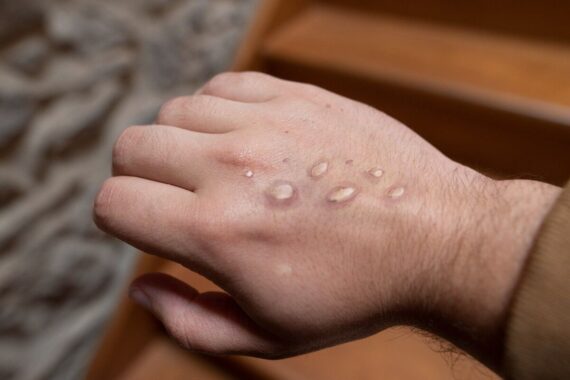Monkeypox cases may be being missed because symptoms look like an STI

A new list of clinical symptoms in people infected with monkeypox has been identified by UK researchers.
An analysis of 528 confirmed infections at 43 sites in 16 countries between 27 April and 24 June 2022 found that many of the infected individuals reviewed in the study presented with symptoms not recognised in current medical definitions of monkeypox
Many cases had single genital lesions and sores on the mouth or anus and because they are similar to those of sexually transmitted infections, the symptoms can easily lead to misdiagnosis, the researchers warned.
In some people, anal and oral symptoms have led to people being admitted to hospital for management of pain and difficulties swallowing, they said.
Misdiagnosis can slow detection and thus hinder efforts to control the spread of the virus
In the infections looked at, 98% were gay or bisexual men. Although sexual closeness is the most likely route of transmission in most of these cases, researchers stress that the virus can be transmitted by any close physical contact.
Reporting in the New England Journal of Medicine, the researchers said 95% of the cases presented with a rash (with 64% having <10 lesions), 73% had anogenital lesions, and 41% had mucosal lesions, with 54 having a single genital lesion).
Common features preceding the rash included fever (62%), lethargy (41%), myalgia (31%), and headache (27%).
Public health measures – such as enhanced testing and education – should be developed and implemented working with at-risk groups to ensure that they are appropriate, non-stigmatising, and to avoid messaging that could drive the outbreak underground, the researchers said.
Professor Chloe Orkin, professor of HIV Medicine at Queen Mary University of London and Director of the SHARE collaborative, said: ‘Viruses know no borders and monkeypox infections have now been described in 70 countries and in more than 13,000 people.
‘We have shown that the current international case definitions need to be expanded to add symptoms that are not currently included, such as sores in the mouth, on the anal mucosa and single ulcers.
‘These particular symptoms can be severe and have led to hospital admissions so it is important to make a diagnosis. Expanding the case definition will help doctors more easily recognise the infection and so prevent people from passing it on.’
Dr John Thornhill, consultant physician in sexual health and HIV and clinical senior lecturer at Barts NHS Health Trust and Queen Mary University of London, added: ‘It is important to stress that monkeypox is not a sexually transmitted infection in the traditional sense; it can be acquired through any kind of close physical contact.
‘However, our work suggests that most transmissions so far have been related to sexual activity – mainly, but not exclusively, amongst men who have sex with men.
‘This research study increases our understanding of the ways it is spread and the groups in which it is spreading which will aid rapid identification of new cases and allow us to offer prevention strategies, such as vaccines, to those individuals at higher risk.’
The research also found monkeypox virus in 29 of 32 of semen samples tested from people with monkeypox but they said more work is needed to understand the implications of that.
Earlier this month, the UK Health Security Agency advised men who have had a confirmed case of monkeypox to wear a condom during sex for 12 weeks after complete recovery
After 12 weeks and up to six months after recovery from infection, it is also recommended that a monkeypox PCR is done on semen samples (and where necessary, oropharyngeal and/or rectal swabs) for patients undergoing fertility treatment or planning pregnancy, is undergoing planned semen storage, or has an immunocompromised sexual partner (including a pregnant partner).
As of the 18th July 2022, there were 2,137 confirmed cases in the UK, 2,050 of which were in England.
UKHSA said it had procured more than 100,000 additional vaccine doses as well as updating its guidance to advise that close contacts won’t need to isolate at home if they don’t have symptoms.
Pulse October survey
Take our July 2025 survey to potentially win £1.000 worth of tokens

Visit Pulse Reference for details on 140 symptoms, including easily searchable symptoms and categories, offering you a free platform to check symptoms and receive potential diagnoses during consultations.
Related Articles
READERS' COMMENTS [1]
Please note, only GPs are permitted to add comments to articles











Is it possible that cases of monkey pox have been around for a long time, but misdiagnosed as chicken pox or herpes? Cannot imagine any GPs tested for monkey pox prior to current episode, or that many doctors even knew of it’s existence.
Have any serological surveys been done? Anyone know?